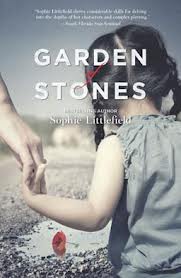Garden of Stones switches from a modern-day (1978) murder investigation to a setting in the Japanese relocation camps, the flashbacks being the majority of the action. As with so much WWII fiction, the story opens in December 1941. From this the reader should know what to expect.
An only child of a well-off Japanese family, US-born Lucy Takeda is so privileged that she conceals the extent of her doll collection and dresses from the other girls in the eighth grade. Her father, much older than her frail and damaged, yet famously beautiful, mother, Miyako, owns an importing business. We have just a few days to get to know the Takedas before the Japanese attack Pearl Harbor.
Immediately, families are required to burn their heirlooms, lose their businesses, and sell their remaining possessions for cents on the dollar. Lucy’s father had just died and was spared this humiliation. Lucy, fourteen and on the road to inheriting her mother’s beauty, is sent to the Manzanar camp with her mother, a suitcase each. There, they are at the mercy of American overseers, living in rundown, quickly built, vermin-ridden barracks with all the usual inadequacies of food, heat, plumbing, and privacy. Everything beautiful has been taken away from them. Manzanar was famously harsh, beginning with the climate.
For the internees, there is always the hope that the war will end and indeed, as time goes on, some Japanese are allowed to leave, either to enlist or work in the war effort or in agriculture. After a series of tragedies and injustices, Lucy begs to be allowed to leave for a job, and goes from the rundown and abusive conditions of the camp to the unpleasantly named, abusive Sloats who own a rundown motel. Mrs. Sloat’s brother also lives there, a disabled veteran who teaches Lucy an odd trade, and who greets her, not at all unusually for that time, with “You can go to hell. You and every other Nip left on this planet.” Everyone at the motel is disabled, bitter, and legally bound to each other one way or another.
This job was supposed to be an escape, a way to put the pain of her mother’s death behind her; instead, she found herself right back in the crossfire of human emotion. Was there nowhere on earth for Lucy to escape, to start a life free of anguish?
What is the garden of stones: the traditional Japanese rock garden that Lucy envisions in both bleak places she lives, or the group of damaged people who have allowed physical deformities to form scar tissue over their humanity?
Refreshingly, this book is not an anti-internment screed, but one that uses that setting to discuss the lives of the formerly beautiful and whole. Nor does it judge by revisionist standards the wisdom of the swift and harsh relocation. Even the odd hobby that Lucy learns involves trying to recapture the beauty of a living thing. It is further a discussion of mothers will go to to protect their daughters, and how it sometimes takes generations to end the cycle of violence.
The modern-day sections serve to resolve and reveal the injustices of the past. Woven through Garden of Stones as well are such contemporary concerns—for us, if not in 1978—as the ease of buying a gun, power-mad military men, distrust of immigrants, and abuse of young boys.
Guest reviewer: Christine Frank
Garden of Stones
Sophie Littlefield
Harlequin MIRA
Novel
320 pages
